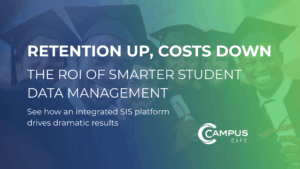
Launching a new SIS is not just a plug-and-play operation, it’s a comprehensive, multi-step implementation process.
“Get the system up and running on schedule, with minimal downtime,” is a common refrain we hear from many IT leaders.
While that’s always the goal, it’s important to set expectations on what an implementation looks like for your school.
After implementing Campus Cafe’s SIS at hundreds of schools, we’re sharing our time-tested best practices and advice from real customers to ensure your school experiences a smooth transition.
1. Develop a Realistic (and Flexible) Timeline to Launch
Launching a new SIS involves multiple phases, with each phase requiring its own discovery, due diligence and validations.
Huntingdon College is a four-year non-profit college with approximately 1,000 students. It initially budgeted a year to move from Ellucian’s PowerCampus to go live with Campus Cafe, but school leaders soon realized they needed a few extra months to configure the system properly.
Vice President of Technology Anneliese Spaeth notes that finetuning the admissions workflows was critical because admissions data flows into all other departments, including billing, financial aid and registration.
“If you do not get admissions right, nothing else is going to flow correctly […],” said Spaeth. “We spent a lot of time creating activities and workflows and it was worth it.”
Timeline Considerations to Implement an SIS
Veteran technology administrators say flexibility is essential when determining a launch plan.
Keep these considerations in mind when devising an implementation timeline:
Academic Calendar
For non-profit, semester-based schools, avoid launching during the beginning or end of the semester or module. You don’t want to be offline during busy registration, grading or billing times.
Career and trade schools often operate in modules with breaks, so target a quiet period between sessions.
Also consider the financial aid year and timing of student federal loan origination. Steer clear of those windows to avoid disrupting financial aid disbursement or reporting schedules.
Vacations and Holidays
Summer, November and December are a prime times for implementation since students are away from campus and administrators have more bandwidth for the project, but it’s also when your staff may be requesting time-off.
Ensure key stakeholders, including department heads and IT staff, are on-site for training, launch and troubleshooting.
Amount of Data to Load
If your school requires a data conversion, adequate time must be given to convert the data, go through the data validation process and make changes.
Number of Automated Processes and Integrations
Setting up and testing the workflows and integrations for digital signatures, single sign-on, text messaging and email relay communications are time-intensive tasks that require input from all system users.
2. Identify Key Stakeholders
Adhering to timelines requires on an open line of communication. Campus Cafe assigns each school a dedicated project manager who works with your school’s assigned project manager. Identifying a main point of contact helps to streamline the flow of information and keep launch times on track.
As the project manager at Huntingdon College, Spaeth regularly checked in with her department heads and frequent users, also known as power users, for progress updates.
Additionally, she recommends that school project managers personally review the data, request regular updates on data migration and conversion, coordinate department training and be available for troubleshooting.
“Know your data and don’t just assume each office is checking the things that you ask them to check. Be hands-on,” she advises.

3. Determine What Data to Transfer
Before your school begins migrating its data, it first must determine which data to keep.
Schools primarily choose to migrate biographical data, transcripts, student financial ledgers and student records.
When career school Mildred Elley migrated to Campus Cafe, Chief Academic Officer Ken Clough said administrators used the opportunity to parse their data and remove outdated or unreliable information.
Information that can be removed includes duplicate student information, former course information, old emails and contact information.
It’s important to note the factors that can influence data conversion costs. To outline the scope of your school’s data conversion, consider these factors:
Volume of Data
This is the number of data fields that need to be converted (not to be confused with the number of records, which is less important).
Type of Data
Examples include biographical information, billing, student attendance, grades and career placement.
Cleanliness of Data
Are there duplicate data fields, mixed type fields, errors, etc., that need to be scrubbed and cleaned?
After deciding what data to keep, several options exist for migrating student data, including manual data entry, doing a complete data conversion or data archiving.
4. Begin the Data Validation Process
Your new student information system will create a single source of truth for all users. But before you can utilize the system’s best functions – like automated workflows, dashboards and reports – you must first validate your data.
Verifying data accuracy takes time and attention, and requires an intimate level of familiarity with the data, so your school’s project manager and department heads need to be directly involved.
When Mildred Elley transferred its student enrollment and activities data from its legacy system to Campus Cafe, users say it improved reporting and analysis. “Going forward, we have much easier ways of verifying data,” Clough notes.
While data validation is time-consuming, it is a critical step in the implementation process. Importing inaccurate data can jeopardize the functionality of your new SIS, resulting in broken workflows and incorrect information.
Also, correcting bad data after the system goes live is more complicated, so it’s important to take the time to do it right.

5. Configurations and Third-Party Integrations
Once the data is validated and accepted, Campus Cafe configures each module by department to meet the specific needs of your school. We also help your school configure reports and customize forms tailored to your specifications, while setting up rules, filters and notifications.
This is also the time that third-party integrations are configured. Popular integrations include payment systems, single sign-on options, email and texting services, financial aid modules and learning management systems.
Once the new system is live, we focus on core functions that are necessary to run the school. Most schools don’t need every feature and integration at launch, so we recommend approaching your migration as a phased-in process.
Whether you’re a small trade school or a larger four-year non-profit school, start with the foundational elements, get those running smoothly, and then add more advanced features and integrations as your team gets more comfortable with the software.

6. Schedule Training and Support
When launching a new SIS, there will be a learning curve and change management considerations, but proper training will set your school up for success.
As staff at Mildred Elley learned the system, users identified critical areas to start with and then began to explore more functions.
“90% of the data that users want from the system they can get on their own using the student finder. And as we’ve gone through the implementation, people are getting more sophisticated,” says Clough.
Tips to Manage Training
It’s important to choose a technology partner with a managed support desk that responds quickly, is available after hours and on weekends, and offers an extensive online knowledge base so users can proactively get help.
Administrators note that timely, responsive support is a critical element in managing the launch of a new SIS. “When we have questions, we are heard, and we are helped,” says Jay Ober, President and CEO of International College of Health Sciences.
Below are customers’ top recommendations to ensure all users get the training and support they need.
Hold Your Team Accountable
Ensure your IT team, key stakeholders and primary users attend all the in-person training sessions. Listen to their questions and concerns, share resources and help desk information.
Tailor Training Sessions by User Group
Plan for separate trainings with each department, including admissions, financial aid, the registrar and faculty.
Collect Feedback
After launch, compile your team’s questions and share early experiences for troubleshooting and process improvements.
Plan Ahead
Schedule additional training after several months to help users refine their skills and explore additional modules, or to get new hires up to speed.
A Hands-On Approach to Implementation
Our consulting team makes every effort to reduce the stress, time and effort on your team before, during and after implementation.
Reach out to us for a demo to see how we can customize our implementation services for your school.



